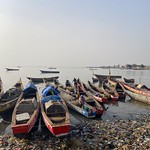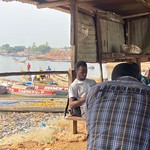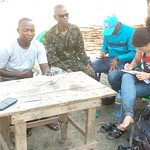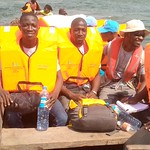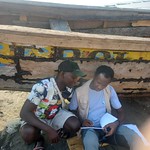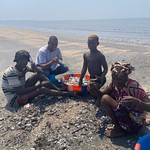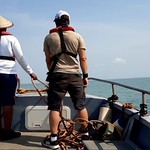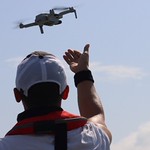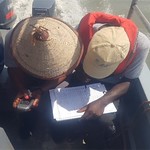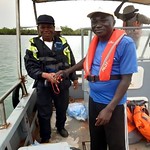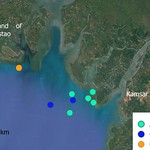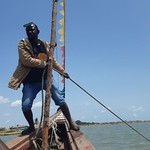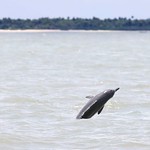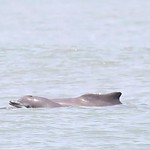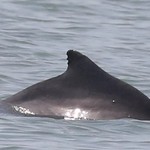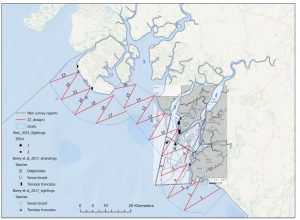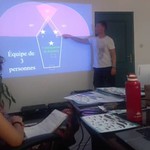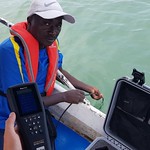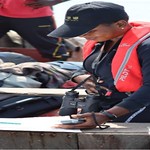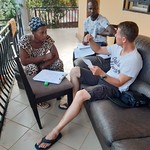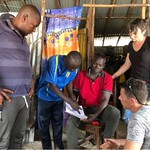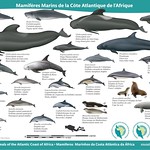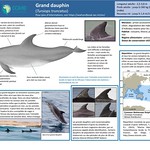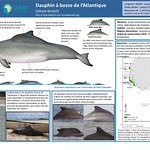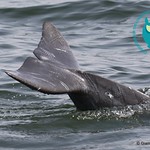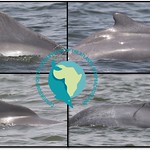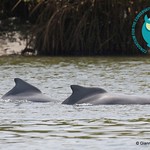Small Grant Login

0% of this project has been implemented.
January 1, 2022
September 30, 2024
Project Summary
The Atlantic humpback dolphin lives in shallow nearshore waters along the Atlantic coast of Africa. Confirmed records of the species are available in only 13 of the 19 countries within the species’ range, including Guinea. While in many countries, records are limited to only a handful of reported strandings or opportunistic sightings, surveys conducted by international and Guinean scientists in 2012, 2015, and 2017 indicate that there is at least one population present along Guinea’s northern coastline, with a minimum of 47 animals individual dolphins identified. The species is designated as Critically Endangered on the International Union for Conservation of Nature’s Red List of Threatened species. The main threat to the species is accidental catch in fishing nets and other gear.
This project will assess the distribution, habitat preferences, and abundance of Atlantic humpback dolphin in Guinea. Noting its key habitats, the study will also carefully document the threats to the species and work with Guinean stakeholders to develop recommendations to minimize these threats to help the dolphins continue survive. Once more is known about the status of dolphin in this area, efforts will be made to collaborate with local communities to conserve it into the long-term future.
Objectives
Research: Conduct systematic boat-based and interview surveys to document the species’ distribution, habitat preferences, and threats in Guinea, establishing a baseline that will allow assessment of population trends into the future.
Outreach: Collaborate with local communities, particularly fishers, to minimize the threat of accidentally catching the dolphin in fishing gear, and collaborate with relevant government and industry stakeholders to raise awareness of the species’ conservation needs and measures that can be taken to protect habitat and mitigate the impacts of coastal development and other human activiites.
Key Documents
Project location - Guinea, Africa
Field Reports
Challenging Weather Conditions Impact June Survey Results
June 15, 2023
Surveys were conducted in two newly designated study areas:
- the estuarine waters near the town of Boffa and
- the waters surrounding Conakry and the Iles de Loos.
In total, 138 km were surveyed in the Boffa area, while 175 km were covered around Conakry and the Iles de Loos. Unfortunately, these surveys did not result in any sightings of Atlantic humpback dolphins, which may have been influenced by largely unfavorable weather conditions. Despite this setback, the surveys offered valuable opportunities for capacity building and training for Guinean researchers from CNSHB and Biotope Guinée.
More than 230 stakeholders surveyed
December 10, 2022
After testing the structure and format of a questionnaire with local fishermen in Bonfi, the research team was able to make adjustments before conducting first round surveys in the Forécariah area over a period of eight days.
From February 01 to 08, 2023, eight trained sociologists were deployed to five ports in the three sub-prefectures of Benty, Kaback and Maférinya: Sourinéné, Khounyi, Matakang, Rapata and Sangbon (Touguiyiré, see figure below). They managed to interview 202 fishermen and 28 other stakeholders, including port managers, fishmongers, conservationists and local authorities.
The data collected via the Kobocollect mobile application will be analyzed and contribute to the development of conservation plans to protect the humpback dolphin.
Click each thumbnail to enlarge and read the captions.
1033.7 km navigated in search of the Atlantic Humpback Dolphin
November 30, 2022
The project team consisting of 4 researchers (including two women) embarked on the second of five boat surveys in the search of the Atlantic humpback dolphin. They navigated Kamsar and the Tristao Island to cover 1033.7 km.
The surveys yielded good results as they recorded a total of 7 sightings, including 2 sightings of Atlantic humpback dolphins (groups of 10 and 6 respectively), as well as 5 sightings of the common bottlenose dolphins.
Having spotted and identified 13 previously marked individuals, the team can compare this with records from the June trip to provide insights into movements and ranges. Given sufficient sample sizes, they can also be used to generate mark-recapture abundance estimates of the population.
Click each thumbnail to enlarge and read the captions.
Five sightings of Atlantic humpback dolphins
June 30, 2022
Boat surveys were carried out between 5th and 20th June 2022 off the Río Nuñez Estuary and around the Tristao Islands. Despite weather and logistical constraints, eight survey days were conducted at sea, navigating 560.6 km for more than 50 hours in total. Each boat survey comprised of three or four observers and two or three local fishermen acting as guides. A total of eight dolphin sightings were recorded, including five sightings of the Atlantic humpback dolphin, two sightings of the Common bottlenose dolphin (Tursiops truncatus) and one of an unidentified dolphin species. The size of the Atlantic humpback dolphin groups ranged between one and 12 and calves were recorded in four out of the five sightings.
Information on time, GPS position, sea conditions, visibility and speed were collected at regular intervals. Boat navigation tracks and dolphin positions were recorded and when sea conditions permitted, habitat readings including depth, temperature, salinity and pH were collected using the YSI meter. An attempt was made to photograph dorsal fins of all members of the group, for individual photo-identification and although a detailed processing of photographic material is currently ongoing, based on preliminary matching, at least 13 well-marked individuals were photo-identified. While this is a small sample size, these first results suggest that the waters off the Río Nuñez Estuary, and particularly west of the island of Taidi, may be an important habitat for this species. Further photo-identification data will help elucidate any long-term patterns. Analysis of photographic data from this survey and subsequent surveys will enable a better understanding of population size, connectivity, social structure, residence patterns and site fidelity of this local population.
As part of the project, new collaborations, partnerships and synergies were also developed with local fishermen, fisheries authorities and marine protection area managers. The local ecological knowledge of fishermen and local communities helped our team to gain a better understanding of the diversity and occurrence of whale and dolphins in the area, which will help guide further research efforts. Newly forged relationships will also augment collection of data on sightings and strandings of Atlantic humpback dolphins through the direct involvement of local fishermen.
Enjoy all the photographs from this expedition by visiting this flickr photo album
Click the thumbnail to enlarge it and read the captions.
Sampling plan finalised for the first boat mission survey
June 5, 2022
Protocols were developed by the Atlantic Humpback Dolphin Conservation Consortium (CCAHD) for surveys of the Atlantic humpback dolphin (Sousa teuszii). By providing standardised methods it is hoped that the results of surveys conducted can be more easily compared and used to understand relative abundance and habitat preferences of the species. These protocols will also be used to train teams in the field and serve as a reference for trainees when setting up their own investigations in new locations.
For the 23 transects were created to cover the area between Kamsar and the border with Guinea Bissau, focusing on areas where Sousa teuszii has been previously observed. The transects were designed to achieve uniform coverage of the area, while considering the changing morphology of the area (sandbanks and islands) and the distance between the vessel and the research bases. The planned transects allow a maximum distance of 70-100 km per day, dependent on the number of dolphin sightings made and the time spent with the dolphin groups to collect photo-identification and habitat data, indispensable for future analyses. The team will record observations of human activities that may impact dolphins or their habitat, including fishing activities, aquaculture, maritime traffic and mangrove clearing and will also map and record sightings of other wildlife.
The main objectives during the investigations are to document the distribution and abundance of Sousa teuszii by establishing a photo identification catalogue of the dorsal fins of each individual dolphin encountered, to understand their movements, range, residence patterns and social structure. At regular intervals during the survey and at the location of each Atlantic humpback dolphin sighting, data will be collected on the salinity, turbidity, depth and temperature of the water. We will then be able to start to draw statistically significant conclusions enabling us to predict where the dolphins may be found in areas that have not been studied and to understand how changes in the environment, caused by coastal development or climate change, might affect the species.
Research team training by Cetacean expert
June 3, 2022
A training session for the research team performing the boat survey in June, was held in Conakry on the 3rd of June 2022 and led by Tilen Genov, CCAHD expert on Cetaceans. The training covered a variety of different topics including a general introduction to whales, dolphins and porpoise, a presentation of the Atlantic humpback dolphin (AHD) and the differences between other dolphin species and the use of scientific equipment for cetacean observation. The trainees were taught how to use marine binoculars to assess the dolphin’s demeanour, the angle of the dolphin to the boat and marine GPS to record the geographical positioning of each sighting. They were shown how to use the cameras to take pictures of the dorsal fins and how to use a YSI multi-parameter to record different water parameters such as temperature, salinity and turbidity to collect information on AHD habitats.
During fieldwork, the Guinean trainees and researchers were given opportunities to practice and consolidate skills in standardised cetacean search and observation techniques, photography, effort and sightings data collection and sampling of water parameters. They were also involved in the downloading of GPS, photographic and water parameter data and the entry and archiving of data at the end of each survey day.
Raising awareness and capacity development
May 31, 2022
To raise awareness of the Atlantic humpback dolphin (AHD) and to support community workshops and capacity building, colouring sheets, posters and social media content are being developed in addition to training presentations and identification guides to distinguish the different dolphins. Our team are also planning to create a children’s picture book and as a first step images of local coastal communities and settings have been sent to the illustrator Howard Gray, while Biotope Guinea is engaging with different organisations to find local storytellers who can collaborate with the illustrator to ensure that local folklore and cultural elements are used for the scenario and text.
Preparation and implementation of the interview survey underway
April 30, 2022
The Atlantic Humpback Dolphin Conservation Consortium (CCAHD) researchers, in coordination with Dr Samuel Turvey from the Zoological Society of London, have developed a standard interview questionnaire to be used throughout the Atlantic humpback dolphin range. The questionnaire was then reviewed and approved by an Independent Review Board (IRB) at San Francisco State University. This now clears the way for the Guinea team to be able to begin conducting pilot interviews to test the suitability and length of the questionnaire, as well as how well the meaning and responses translate into languages spoken in coastal communities. The team will also work with CCAHD and Dr Samuel Turvey to develop training materials and detailed protocols for the implementation of the surveys, including sampling strategies for each village, and templates for the electronic storage and analysis of questionnaire results. These feasibility surveys and the training of six people will begin in Boussoura in October, after which they will be deployed in the field.
Conservation assessment of the Atlantic humpback dolphin in Guinea
February 28, 2022
Project news will be reported on this page and for further information see the team’s website available here.
Jan '22: Atlantic humpback dolphin project kicks-off in Guinea
January 1, 2022
The Consortium for the Conservation of Atlantic Humpback Dolphin (CCAHD) and Biotope are joining forces in Guinea to gather baseline data on the dolphin and assemble local talent and expertise to ensure the long-term survival of this endangered species. The Atlantic humpback dolphin is listed as Critically Endangered across west Africa; however, the size of the population in Guinea is mostly unknown because research has not been conducted here since 2015. This project and its partners stand to transform our understanding of AHD in the country.
Project news will be reported on this page and on the team’s website available here.














